A Davenport history feature, written by Charlie Hulme
Davenport Station home | Index to History pages
info@davenportstation.org.uk
Contents
The old Jolly SailorThe new Jolly Sailor
Charlestown House
The shops
Why so Jolly?
Why Charlestown?
Residents in 1841 | 1851 |1911
Brewery history
Carlton House school
Dame Wendy Hiller
Kay Brothers
Charlestown 1960
The 1891 sale notice
References & Thanks
Before the railway established a station on Bramhall Lane and called it Davenport after the local landed gentry, there was no settlement named Davenport, and very few houses along the Turnpike Road between Bramhall and the edge of the township of Stockport.
The farmsteads of Yew Tree Farm and Grange Farm were the only habitations for some distance to the south of the station site, with the exception of a cluster of cottages a short distance north of Bramhall Lane's junction with Woodsmoor Lane, which went by the name of Charlestown, for reasons which so far have evaded local historians.
This feature relates what we have discovered: a somewhat incomplete story. Hopefully readers can help add to it.
Why so Jolly?
The origin of the names 'Charlestown' and 'Jolly Sailor' is a rich source of speculation. There are others in Cheshire, notably in Macclesfield and (now-closed) inn in Marple, both apparently dating from the name period.
The local legend about the inn is that the sailor in question was Salusbury Pryce Humphreys (1778-1845) who joined the British Navy in 1790, and became notorious when in 1807 as captain of HMS Leopard he exceeded his orders by ordering his fire on American frigate USS Chesapeake which was suspected of harbouring British deserters. An 'international incident' ensued, and he was recalled to England.
However, it was not until 1810 that he married Maria Davenport, who later inherited Bramall Hall, and became a prominent citizen in Stockport. When his wife inherited the Davenport estates at Bramall in 1838 he added the name Davenport to his, becoming Salusbury Pryce Humphreys Davenport.
The name 'Jolly Sailor' does not appear in the 1841 census, although this does not prove that the house was not named at the time. He died in 1845; is it possible that it was named in his memory?
William Davenport Davenport, son of Salusbury and Maria began the large-scale sales of land from the estate for housing development, and was responsible for persuading the railway company to provide Davenport station. [Contents]
Why Charlestown?
As for Charlestown or Charles Town, a name which was already in use by 1831, a tenuous connection might be made with Charleston, South Carolina, or the Charlestown naval base near Boston, Massachusetts, but we believe the most likely explanation to relate to an eighteenth-century farmer and owner of the buildings, Charles Croft of Bramhall (see main story).
Charlestown in Cornwall is named in a similar way, having been established by a Charles Rashleigh in the 1790s.
[Contents]
Brewery history
Daniel Clifton, who built the modern 'Jolly Sailor' began a career in brewing as the licensee of the 'Royal Oak' inn in Higher Hillgate, brewing his own beer and living on the premises. Around 1850, he began to all sell his product to other local hostelries. In the early 1880s he transferred brewing activities to a new purpose-built brewery, named the Royal Oak Brewery, drawing water from a 240-foot deep well sunk on the site.
By the time the imposing new Jolly Sailor was opened in 1895, the firm had become a limited company, the third biggest brewer in Stockport as well as producing mineral waters in an adjacent factory fed by a 500-foot well. In its heyday, the Royal Oak brewery was supplying over 70 pubs in Stockport and its southern hinterland, including the Bamford Arms on Buxton Road and the Blue Bell in Shaw Heath. Daniel, who in later years lived at Lyme View in Davenport opposite the station, and finally in the old mansion known as Mile End Hall, in Mile End Lane, died in 1900, but the firm continued.
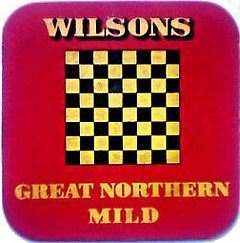
In 1923, the brewery and its 'tied houses' including the 'Jolly' were taken over by the Walker and Homfrays. In 1949, Walker and Homfrays merged with Wilson's Brewery of Salford to create Wilson and Walker Breweries Ltd, a name shortened to Wilson's Brewery in 1952. The Royal Oak Brewery itself ceased production in 1957, and stood empty for many years until the building was incorporated in a housing development by the Equity Housing Group, opening in 2012.
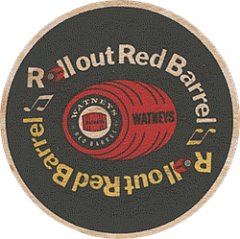
In 1960 Wilson's was merged into the Watney Mann group, purveyors of 'Watney's Red Barrel' (later 'Watney's Red') keg beer which some readers will recall fondly from the days before the Real Ale revival. The Wilson's trading name was retained initially, including the 'chessboard' logo which was found on every Wilson's pub.
In 1974 Watney's was sold to Grand Metropolitan Hotels in the shape of their Lanchester Taverns subsidiary. The early 80s, under the name 'Pennine Hosts' the company joined the trend for 'Young People's Pubs' (or 'fun pubs'). To quote from an article on the 'Curmudgeon' blog:
'Take one struggling pub, preferably one on a prominent site, give it a makeover including pool tables, wall-to-wall TV screens, bright lights, loud music and garish decor majoring on white and bright pink, strip out bench seating in favour of high-level stools, give it a new name with an S on the end such as Chaplins or Bogarts, and there you go.'
Fortunately, this fad did not last, and the proposed renaming to 'Sloane's was abandoned when local people showed their displeasure.
By the 2000s the new trend was to serve a range of food, potentially a source of more profit than heavily-taxed alcohol, and very many pubs have closed - blamed by some on the ban on smoking in public enclosed spaces imposed by the Government in 2007, and by others on the availability of cheap take-home alcohol from supermarket chains. The law against 'drinking and driving' has also played its part, but there has also been a general drift away from the idea of 'popping out for a drink.'
In recent years there have great upheavals in the pub world, partly led by Government legislation, and through a chain of deals almost impossible to follow, by 2018 the Jolly Sailor found itself one of over 3,000 pubs, restaurants and hotels owned by Suffolk-based brewer Greene King.
Charlestown in 1841
In 1841 adult ages were given to the nearest 5 years, and ag.lab referred to an agricultural labourer. Birthplaces were not recorded.James Croft (55) Beer seller
Mary Croft (wife,30)
Sarah (daughter, 9)
William Pegg (ag.lab, 24)
Martha Pegg (wife, 22)
Ann Pegg (daughter,3)
Thomas Pegg (son, 5 mo)
Robert Mod Rinson (?) (25), ag.lab
Ann (wife, 25)
George (son, 3)
James (son, 9 mo)
Peter Downs (40) ag.lab
Nanci Downs (wife, 25)
Matilda Downs (8)
Elizabeth Downs (6)
Thomas Downs (4)
Thomas Clark (20) collier
Sarah Rhodes (60)
Sarah Rhodes (30) silk weaver
Margaret Rhodes (20) silk weaver
Ann Rhodes (20) silk weaver
John Beard (55) ag.lab
Betty Beard (40)
William Beard (20) ag.lab.
Joseph Beard (11)
Edward Beard (5)
Hannah Beard (9)
(Alice Leather, mentioned on the Tithe record of the same year, is not listed.) [Contents]
Charlestown in 1851
Matthew Pickford (39) Farmer's labourer
Elizabeth Pickford (40) Housewife
Mary Pickford (8) Daughter
Sarah Ann Pickford (5) Daughter
Mark Minshall (40) Beer seller, farmer of 12 acres, labourer
Elizabeth Minshall (40), House wife, born in Adwalton, Yorkshire
William Minshall (4) Son
Amelia Minshall (10 mo.) Daughter
Ann Downs (10), servant
William Perry (38) Farm Labourer born in Leek, Staffordshire
Martha Perry (31) born in Disley, Cheshire
Mary Parry (7) daughter
William Perry (4) son
Thomas Perry (9 mo.) son
George Jackson (37) Labourer, Agr.
Martha Jackson (31)
Abie(?) Jackson (Daughter,7)
Sarah Rhodes (widow,77) 'now pauper'
Sarah Rhodes (daughter, 42) Silk weaver by Hand
John Beard (67) General Labourer
Born in Chapel-en-le-Frith
Elizabeth Beard (56)
Edward Beard (son, 15)
Elizabeth Beard (daughter, 7)
Jolly Sailor, 1911
John Royle (58), Publican, b. Oldham, Lancs.
Jane Ann Royle (53) wife, assisting in business. b. Ashton
Ann Royle (31) daughter, assisting in business, b. Oldham
Lily Marshall Royle (27), daughter, employed in wholesale bakery, b. Oldham
Emily Royle (25), daughter, assisting in business, b. Manchester
Ethel Royle (18), daughter, assisting in business, b. Denton
James Johnson (32), Hotel waiter, b. Cheadle
John and Jane, married for 32 years had seven children, two of whom had already died. [Contents]
Kay Brothers
Born in Heywood, Lancashire in 1833, said to me a great-great grandson of John Kay, inventor of the 'flying shuttle', Samuel Kay came to Stockport to work as a 'shop man' at a chemist and druggist's shop at 7 Lower Hillgate, Stockport, which had been established there in 1786 by Ollive Sims, who later formed a partnership with Alexander Henry Shaw, in 1824 by Shaw alone, later passing to 'Hornby and Sons', a firm established by Edward Preston Hornby, who moved to Stockport from Yorkshire and his son Charles Haydock Hornby.
The 1861 census shows Samuel Kay apparently living above the shop with two colleagues, John Stafford and John Birkett, and a servant, Elizabeth Jepson.
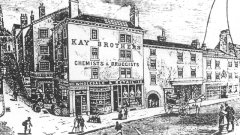
The building at 7-9 Lower Hillgate, on the corner of Rostron Brow - shown above on a company letterhead - was already antique when Kay arrived. A house called 'Rock House' occupied the site in the seventeenth century, later used as an inn, the 'Bull and George'. Dr Henry Heginbotham, the leading historian for Stockport and major of the town in 1867-8, was born at 7 Lower Hillgate.
(Note: there is some doubt about the above: the inn may have been No.13.)
In 1865 Samuel took over the business, joined in 1867 as a partner by his older brother Thomas the following year to become Kay Brothers, which was incorporated as a limited company in 1887.
It appears that the Kays initially rented the shop from the Hornbys, as records show that the Hornbys sold it to them in 1883 following the death of Charles Preston Hornby, whose wife and family carried on in the chemist and druggist business on the outskirts of the town from a shop at what was then known as 'no. 139 Heaviley'.
In 1882 Kay Brothers obtained additional premises in a disused cotton mill on St Petersgate, Stockport to expand the manufacturing side of the business.
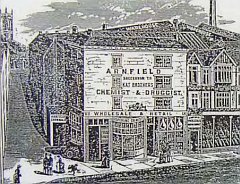
In 1888 they sold the retail business to J.C. Arnfield, in order to concentrate on manufacturing. After 1913 it had a series of users: briefly a bank, then Burton's gentleman's outfitters who at some stage removed the upper floors of the building. By the 1970s it had been demolished altogether and replaced by a new building which latterly traded partly as a pizzeria before being demolished in 2011.
There followed, as a condition of allowing a new building, a detailed archaeological survey was commissioned, which revealed a culvert running through the cellar carrying a stream which possibly ran into the 'Tin Brook', a small tributary of the Mersey.
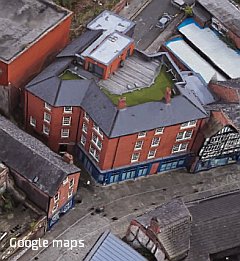
The planning application for the replacement building, which was be flats with shops on the ground floor, were approved on the condition that the facade of the new building should resemble the original chemist's shop. The view above from 2018 shows that this was achieved to some degree; the window layout of the upper floors is a good match..
Among Kay's best-known products was Coaguline, a 'cement for broken articles'. Another was fly-paper - paper coated with a sticky substance to trap and kill insects. In 1884 they received a Royal Warrant as chemist to Queen Victoria, possibly for their best-selling 'Compound Essence of Linseed', a cough medicine, also sold in lozenge form.
There were also those tiny black sweets called 'Tic' which people of a certain age might recall from their childhood; they were being sold (probably not with the same formulation) as early as 1877, advertised as 'a specific in neuralgia, faceache, &c. Sold by all chemists'
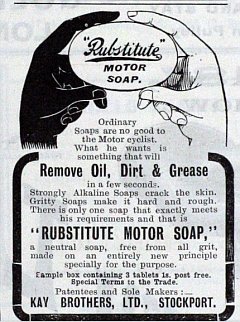
A modern product from 1903.
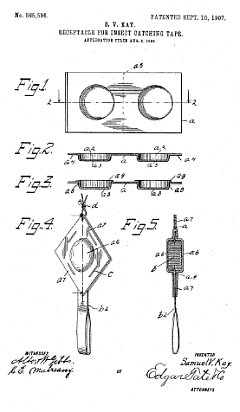
Samuel V. Kay's patent for a receptacle to hold insect-catching tape.
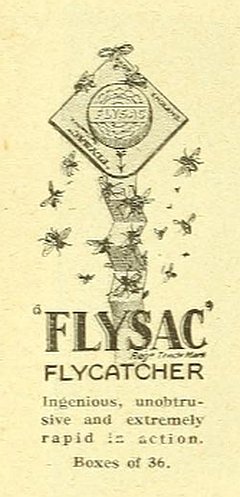
The product in action.
Samuel's brother Thomas, who had his own large villa, 'Moorfield' in Hall Street, Stockport, served a term as Mayor of Stockport, and was an amateur artist and founder of the 'Maia Singers' choir which is still performing in the twenty-first century. He died in 1914.
After 1926 the firm retained the Kay Brothers name; the directors included Edward Hardcastle, son of Mary Kay, sister of Thomas and Samuel. Edward Hardcastle lived for some years at ''Bramall Mount' in Davenport: see our Cale Green Farm and Park feature.
Under later management, in 1936, came 'Zip' firelighters which are still popular today, developed accidentally, the story goes, during attempts to create a sold version of a liquid disinfectant.
In 1937 the works re-located to a works they called 'Kayborough' in Hurst Street, Reddish, north of Stockport.
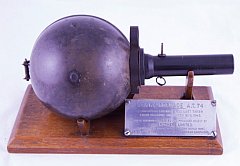
A famous item in its day was the anti-tank grenade or 'sticky bomb' developed by the firm in World War II. The idea was that a solider would throw the grenade at a tank, where it would attach itself due to the sticky material in the spherical part which was filled with explosive.
The 1950s saw polyurethane foam, made under licence from a German company, added to the product range, and in 1953 Kay Brothers moved into Hollins Mill, formerly a textile factory, in Marple.
In 1960 the firm was taken over by the Reckitt, Colman company who moved foam production to another former textile mill in Bollington. This factory, by then trading as Kay-Metzeler, was closed in 2011, and demolished by 2014. [Contents]
Charlestown 1960
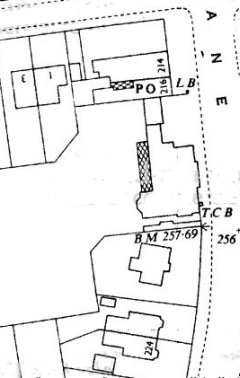
The 1960 Ordnance Survey shows some detail difference from the scene in 2019.
T.C.B. marks the Telephone Call Box, removed in the 2000s, and there was an Ordnance Survey 'bench mark' at 257.69 feet above sea level on a wall which has since been replaced.
The shop at no. 214 had yet to be extended, and the old farm building attached to the pub was still in place. Comparison with the old photograph at the head of the page gives an idea of the relationship between the old and new buildings. The houses 222 and 224 have since been replaced by smaller, more modern houses.
No doubt the bowling green behind the pub was still popular with locals, but was finally sacrificed to the needs of the motor car.
The 1891 Sale Notice
TO BE SOLD BY AUCTION, by Mr. GEORGE R. BRADY, at the Warren Bulkeley Arms Hotel, Stockport, on Friday, the 30th day of January, 1891, at six for seven o'clock in the evening:
The well-known FULLY LICENSED PUBLIC-HOUSE, named the Jolly Sailor at Bramhall, with the Four Cottages adjoining and the Land surrounding the same, containing in the whole 33,980 square yards, or thereabouts. The property lies in a direct line between Davenport and Bramhall Railway Stations, is in the centre of a highly important building estate, and front a good high road. The development of the neighbourhood must largely increase the trade of the public-house. The house could be re-modelled, and part of the land adjoining (comprised in the sale) utilised as a bowling green, &c. Part of the land could at once be sold on ground rent for building purposes. The premises and freehold and free from chief rent, the mines and minerals underlying part of the land are reserved. A liberal portion of the purchase money may remain on mortgage at 4 per cent. Vacant possession of the public-house and vacant land will be given on completion. For plans and further particulars apply to the Auctioneer, St. Peter'sgate, Stockport; Mr. Charles Pierson, survey, 29 Cooper Street, Manchester; or to Messrs CROFTON and CRAVEN, solicitors, 26, Brazennose Street, Manchester.
Tailpiece: The Red Cross Burglar Gang
(from the Manchester Courier, 5 March 1914)Three Stockport boys who, under the awesome title of "The Red Cross Burglar Gang," had carried out several thefts, were brought to book yesterday, when they were before the Bench. The defendants, Leonard Hallworth (13), of Booth-street, and Arthur Hams (13), of Newton-street, were charged with stealing a number of beer bottles from the Jolly Sailor Hotel, Bramhall-lane, and also, in conjunction with another boy, Frank Wagstaffe (12), of Moseley-street, with stealing a bicycle lamp. John Royle, the licensee of the Jolly Sailor Hotel, said that for some time he had missed empty beer bottles trom the yard of the hotel.
The bicycle lamp was missed from a bicycle which was standing in front of a shop in Bramhall-lane. P.C. Critchlow said the previous night he met Hallworth and Harris in Bramhall-lane. Their pockets were bulky, and he found they contained bottles. The boys told him they had stolen them from the Jolly Sailor and taken them to public-houses under the same brewery company and sold them for penny each. The Chief Constable said that Wagstaffe had told the police that they called themselves the Red Cross Burglar Gang, and that they stole things to get money to go to the picture houses. The gang had been in existence for five months and had a sign which was supposed to be known only to themselves, the idea being obtained from picture at a picture house.
Wagstaffe had been previously before the court for housebreaking and larceny. The Chairman (Mr. A. E. Ferns) said the magistrates would break the gang up by sending Wagstaffe to an industrial school and ordering Hallworth and Harris to receive six strokes each with the birch rod. [Contents]
Dame Wendy Hiller
A celebrity who grew up in our area, and was a pupil of Carlton House School was actress Wendy Margaret Hiller. She was a daughter of Frank Watkin Hiller, a cotton mill manager, and Marie Stone; Wendy is recorded in 1939 as Wendy Gow, having married Ronald Gow; at the time she living with her father at 326 Bramhall Lane South, a short walk from Carlton House.
Miss Dorothy's 'elocution' lessons can't have been a sccess, as after Carlton House school Wendy was sent to Winceby House school in Bexhill, Sussex, in the hope that she would lose her northern accent, which her father thought would spoil her marriage prospects.
Her first taste of acting was with the Manchester Repertory Company, with little success until someone was needed to play the part of mill girl Sally Hardcastle in the stage version of Walter Greenwood's novel Love on the Dole in 1934.
She was summoned, and the play toured the country tp great acclaim and even played New York. The play was adapted by Ronald Gow, whom she went on to marry in 1937, followed by appearances in many stage, film and television productions, including Princess
Dragimoroff in Murder on the Orient Express in 1974. Her last film was Countess Alice in 1992.
Wendy Hiller was appointed OBE in 1971 and created dame in 1975
In the 1940s the couple left Bramhall for a house in Beaconsfield, Buckinghamshire, where Wendy died aged 90 in 2003 after a long career in on stage and screen.
Sources
General:
Ancestry.co.uk
Guardian online archive (access via Greater Manchester libraries)
British Newspaper Archive
Directories, newspaper microfilms, electoral registers and manuscript history of Kay Brothers in Stockport Heritage Library
Cheshire Directories
Cheshire Tithe Maps
Jolly Sailor:
The Brewerypedia website
'Watney's Red Barrel'.
Retrowow website.
E. Barbara Dean, Bygone Bramhall. Stockport: Metropolitan Borough Council, 1980.
Wendy Hiller:
Obituary in The Guardian, 16 May 2003.
Wikipedia: 'Wendy Hiller"
Kay Brothers:
Lesley Richmond and Julie Stevenson. The Pharmaceutical Industry: A Guide to Historical Records. Farnham: Ashgate Publishing, 2003.
'Double Bereavement'. Stockport County Borough Express, 28 January 1926.
Oxford Archaeology North: '7-9 Lower Hillgate archaeological investigation'. On-line PDF.
Kay Brothers archives held at Stockport Heritage library. A list of the contents is available online.
Grace's guide to British Industrial History, entry on Kay Brothers
Thanks
To David Cayton for the plaque photograph and much information;
To David Alison for his memories;
to Janet Cropper, Bunny Sims and Mark Jones for Carlton House memories;
To Peter Wadsworth for the 1960s photograph;
To the ever-patient staff of Stockport Heritage Library;
And special thanks are due to Woodsmoor historian Sue Bailey for her father's photograph of the shops, and for her excellent book A History of Woodsmoor (2016) with friendly apologies for encroaching on her her study area.
[Back to Contents]
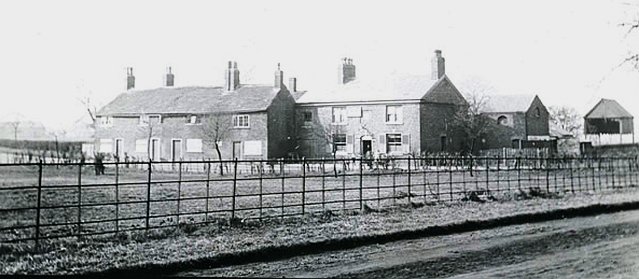
The Tithe Map and record of 1841, which is the earliest detailed map we have of the Davenport area, shows and lists a group of buildings: a farmhouse, four cottages, and a shippon, owned by James Croft and surrounded by farmland (Mile End Farm to the north and Yew Tree Farm to the south) owned by the Davenport family of Bramall Hall. The first one-inch Ordnance Survey map from the 1840s labels the area as 'Charlestown'.
The tithe record shows that James Croft lived and farmed at that time - also renting two small fields nearby from the Davenport estate - along with 'Alice Leather and others.' A Davenport-owned field immediately to the north is labelled 'Charleston [sic] Meadow.' The rare picture above shows the entire settlement, seen from a field on the opposite side of Bramhall Lane. The 'Jolly Sailor' inn is on the right, with its farm buildings behind. The rough track in the foreground is part of 'The Crescent'. Houses were not built on that field until 1898.
Why did a hamlet for farm workers arise at that point? The answer would appear to be a spring (or 'issues'), labelled on old maps as emerging from the ground there and forming a brook which followed the along the northern boundary of the land before meandering through Cheadle to join the Micker Brook which in turn flows into the River Mersey. The (usually dry) path of this brook can be seen today alongside the playing fields accessed from Highfield Close. A later map shows a pump which is visible on old pictures; this stood above the stream which was underground at that point.
In the picture, the cottages appear to have their windows shuttered, suggesting that it was possibly taken not long before their demolition. In general appearance, they seem older that the farmhouse which became the 'Jolly Sailor'.
The 1841 census lists the residents of 'Charles Town' in some detail (see left column). The census taker appears to have reached to hamlet by walking along Garners Lane from his last record at Bates Ley farmhouse, which stood where the Adswood Community Centre was later erected, turning right into Bramhall Lane and eventually - after about three miles - reaching the next habitation, the house of James Croft, aged 55, listed as a 'beer seller', with his wife Mary Jane Croft (30) and Daughter Sarah Hannah Croft (9). This house was clearly the forerunner of the 'Jolly Sailor' inn. It's likely that they brewed their own beer using the water from the spring.
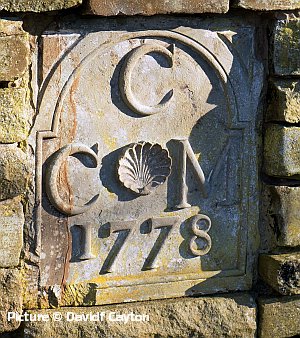 Above the door of the
old inn there appears to have been a dated plaque, giving a
date and what we believe is a record of the married couple
who were perhaps the first residents.
Above the door of the
old inn there appears to have been a dated plaque, giving a
date and what we believe is a record of the married couple
who were perhaps the first residents. Seen in the picture is a plaque, in carved stone, which we believe was from the adjoining building, was found in the rubble from the demolition of that building in 1964. The building, which has left its mark on the wall of the adjacent shop, is presumably the one visible behind the inn in the image at the top of the page. Has anyone a newer picture showing the building?
Another such plaque can be seen today on the farmhouse on Ladybridge Road, Cheadle Hulme, dated 1764, and also including what looks like a weather-worn shell symbol. In heraldry, one of the meanings of the scallop shell, in addition to its well-known association with pilgrimage, is as an emblem of fidelity.
Little has been published about these plaques, which are a feature of several eighteenth-century Cheshire farmhouses. The convention is that the top letter is the surname of the couple, with the first-name initials of the husband and wife below. The identity of the people eludes us at present. James Croft was born c. 1786. In the Cheshire County Archives there is the will of a Charles Croft of Bramhall who died in 1792; we have a copy and investigation of the family is on-going.
It's unusual that, according to the 1841 Tithe map, James Croft owned the plot of land on which his house and the cottages stood, an island in a sea of tenanted land owned by the Davenport family. Adjacent to the farmhouse were the cottages rented by James Croft: three occupied by agricultural labourers and their families, one by a family of silk weavers, and another by agricultural labourers. The census taker's next stops were at Yew Tree Farm and Grange Farm on the road to Bramhall.
James Croft lived most of his life before civil records. From information based on Parish registers we know that he was born in 1774 in Stockport, and his first wife Elizabeth Smith died in 1820. He married Mary Jane Bruckshaw at St Mary's Church, Cheadle in 1828. He died in 1843, and Mary in 1849; their orphaned daughter Sarah, whose birth had been registered in Altrincham, travelled to London to live with her Grandfather John Bruckshaw and his wife, as a general servant in their lodging house, and later married a bricklayer, Barnabus Bone. She died in London in 1904. [Contents]
The Jolly Sailor
The 1851 Census, when the census-taker was walking in the opposite direction, from Bramhall, lists six households in Charles Town; the photographs seem to show a separate dwelling at one end of the pub. The beer seller in 1851 was Mark Minshall; his marriage record from 1846 shows him as a 'farm servant' residing at Mile End, perhaps working at neighbouring Mile End farm. His wife Elizabeth was a daughter of Thomas Barraclough, a clothier. We can assume they took on the Charlestown job after their marriage. An 1850 directory lists Mark Minshall's house in the 'beerhouse' section, distinct from the inns. Ten years later, the Minshall family were still there, with no mention of farming, and the name 'Jolly Sailor' appears for the first time. Mark died in 1867 but his widow Elizabeth Minshall carried on running the pub, and the farm, into the 1870s. By 1881 she was living in retirement nearby; she lived until 1903.
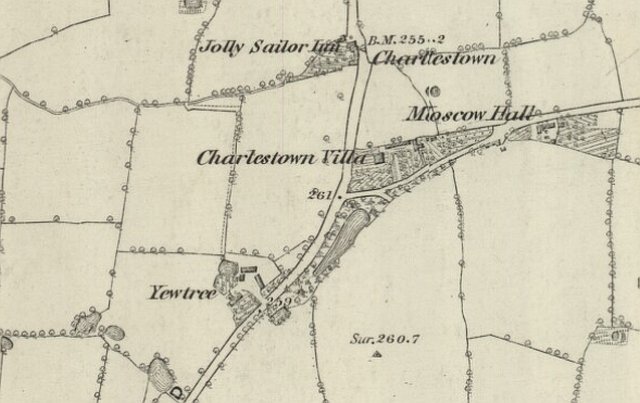
The map above dates from approximately 1872. Notice the long pond, the result of digging for clay, and what appears to be a triangulation survey point at 260.7 feet above sea level in the field. This was still marked in 1910. By the 1930s the area had been bought by the Methodist Church as a playing field for their members - and local lads whose football games would be paused if an interesting loco was expected on the nearby line. The mark (was it actually a column?) had vanished by then; The 1960s onwards saw the land used for a new Methodist Church, later surrounded by housing development known as 'Trinity Gardens'.
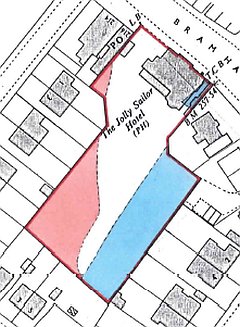 In 1876
the Jolly Sailor and the four cottages were sold at auction,
raising £1800. The buyer was, we believe, James Lamb,
aged 47, born in Manchester, formerly a brick and tile
dealer, who took on the pub. Helping him in the pub were his
wife Fanny Lamb, his daughter Mary Ann
Lamb and niece Eliza Lamb. In 1880 and 1883
James Lamb purchased additional land from the Freeholders
Company (successors to the Davenport family), extending the
grounds beyond James Croft's original triangular plot to
allow the creation of a bowling green. James Lamb died at
the Jolly Sailor, aged just 53, in March 1886, his wife
having died earlier, in 1883.
In 1876
the Jolly Sailor and the four cottages were sold at auction,
raising £1800. The buyer was, we believe, James Lamb,
aged 47, born in Manchester, formerly a brick and tile
dealer, who took on the pub. Helping him in the pub were his
wife Fanny Lamb, his daughter Mary Ann
Lamb and niece Eliza Lamb. In 1880 and 1883
James Lamb purchased additional land from the Freeholders
Company (successors to the Davenport family), extending the
grounds beyond James Croft's original triangular plot to
allow the creation of a bowling green. James Lamb died at
the Jolly Sailor, aged just 53, in March 1886, his wife
having died earlier, in 1883.The Land Registry map, based on a 1965 mapping, shows the 1880 purchase (pink) and the 1883 purchase (blue). The old path of the brook was no longer a boundary.
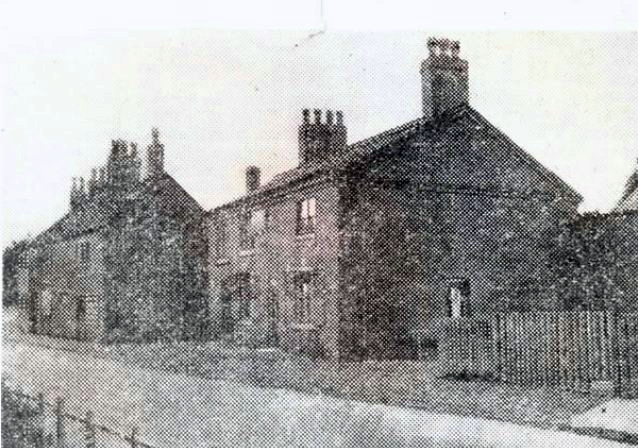
In January 1891 the inn and cottages, with the surrounding land, were sold at an auction conducted in Stockport by George R. Brady; the buyer was brewer Daniel Clifton (see left hand column.) The 1891 census shows a new Innkeeper, Pennell Wood, born in Saddleworth, Yorkshire, a former railway station inspector, had taken over as tenant. This newspaper photograph, published in 1952, is said to show the pub and cottages as they were in 1894, with the pump in the foreground. [Contents]
The new Jolly Sailor
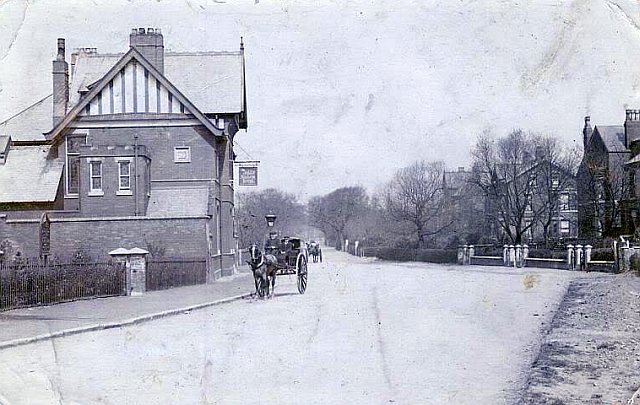
Pennell Wood was retained as tenant of Daniel Clifton, who arranged the demolition of the inn and cottages and had built the impressive edifice which is a landmark along Bramhall Lane. It opened in 1895. The Bullock Brothers postcard (above) dates from the early days of the new building.
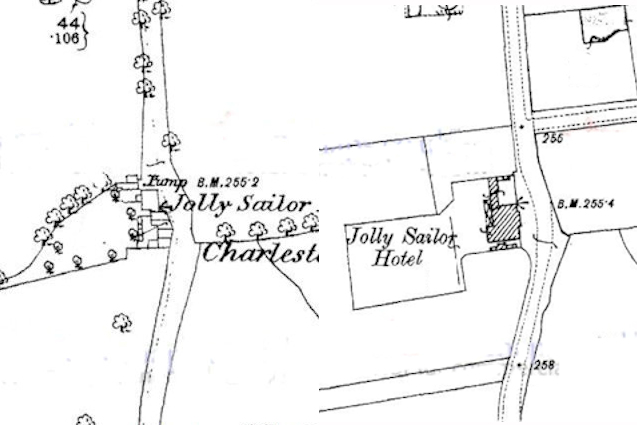
Comparison of maps from 1872 (left in the page above) and 1898 reveal that the new hotel was built largely on a site further back from the road and behind the old buildings; perhaps the old inn stayed open during the building work. They also cast doubt on suggestions that buildings demolished in 1964 (stables?) were the original farm buildings which were at right-angles to the road, although the 1872 map does not match the old photograph at the head of the page. A building certainly abutted the shop next door; a trace of it remains on the end wall of no. 216.
The postcard appears to date from c.1906; the sign board in the garden to the left announces Carlton House school (see below). By that date, new houses had been built around the inn, becoming 220-226 Bramhall Lane and the older houses round the corners on newly-created Ashfield and Barnfield Roads. The tall house on the extreme right is 107 The Crescent, built 1898; the house with windows facing the camera, and the ones beyond on Bramhall Lane no longer exist, having been replaced by modern blocks of flats. The land in the right foreground was still an open field at the time of the picture, and remained so until sold for housing development as part of Samuel Kay's estate in 1927.
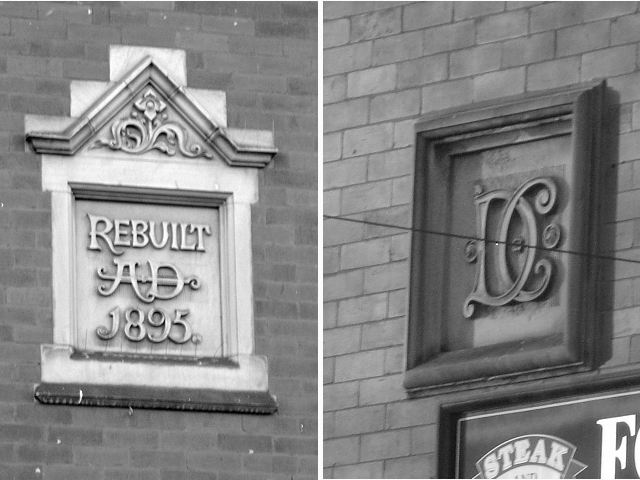
Plaques on the ends of the building mark the data of building and, at the south end, the DC monogram of Daniel Clifton. An 1896 directory lists Pennell Wood as innkeeper of the "'Jolly Sailors’ hotel, wine, spirit, bottled ale & stout merchant; good accommodation for commercials & private parties; billiards & bowling green."
The 1901 census lists the 'licensed victualler' as Joseph Walker, aged 50, born in Baguley, Cheshire. He lived at the inn with his wife Annie Walker (no connection with 'Coronation Street'!) and two members of his family who worked as barmaids: step-daughters Minnie Bleasdale and Florrie Bleasdale, as well as his stepson Frank Bleasdale (aged 20) listed as an architect, and ten-year-old daughter May Gordon Walker. Also resident were a gardener, George Lownes, and a general servant, Emma Stretch.
Joseph's wife Annie Bleasdale, born Annie Hawkinson in 1857 in Cheadle, Cheshire, had experience in the licensed trade, as her first husband, Thomas Bleasdale, whom she married in 1878, had been the publican at the 'White Lion' inn in central Manchester. In 1881 Thomas, Annie, Minnie and Florrie were recorded there. Thomas died in 1887 and the same year Annie married William Gordon of Stockport, only for him to die in 1890. She married her third husband, Joseph Walker, in 1898, so May was also his stepdaughter. By the time of the 1911 census he had given up the pub and was living at 90 Kennerley Road, Davenport, with his Annie and her daughter May, described as a milliner. Joseph gave his occupation at that time as 'Salesman, Firelighters' which strongly suggests that he was employed by Kay Brothers (see below).
Frank Bleasdale went on to marry Nelle Bland and raise a family at 39 Adswood Lane West in Cale Green, working as an Architectural Draughtsman for Manchester Corporation; he died in 1926.The landlord by 1907 was John Royle, born in Oldham in 1853 assisted by his wife Jane Ann Royle and three of their grown-up daughters plus a live-in waiter. John and his family had previously run the 'Queens Hotel' at 324 Manchester Road, Gorton.
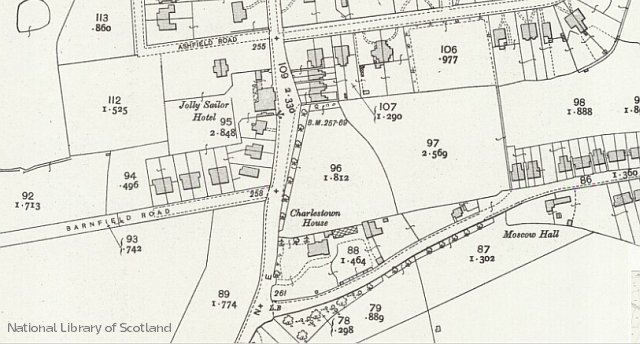
In 1924, the licensee was John Collier, while 1934 and 1939 listings show Ezra Wainwright (b.1879) in charge with his wife Edith Wainwright. Ezra was son of a coal miner from Adlington, Cheshire, who had formerly worked as a coachman for a wealthy family in Cheadle Hulme. He reigned at the 'Jolly' for 27 years.
The Jolly Sailor continued to serve the people of Davenport and Woodsmoor, helped by the fact that the main shopping area around Davenport station has never boasted a pub. David Alison, who lived in Davenport in the 1950s, recalls:
'Back in the 1950's it proudly displayed a bright red neon sign thus:
JOLLY SAILOR
HOTEL
It was obviously run on two separate electrical circuits, but for a long time the right-hand circuit must have fused and the sign read:
JOLLY
HOT
Funny how one remembers such things 60 years on.'
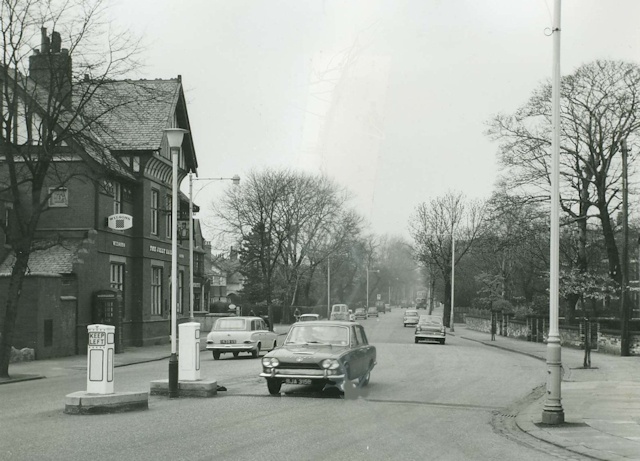
This (slightly damaged) photograph from the 1960s shows the Wilson's brewery 'chequerboard' trademark on display. The 'Belisha crossing' has disappeared, replaced by a refuge, while in the distance a North Western Road Car Company double-decker approaches, probably on route 78 from Stockport to Bramhall.
The 1970s were a time of change for the pub. The fad for 'novelty pubs' saw the interior converted to a ship! Hard to imagine now, does anyone have a picture? The basement was used for discos, and had a pool table. The pub went through some difficult times in the 1980s: during a modernisation in 1983 it suffered a serious fire which wrecked most of the interior, and was threatened with loss of its traditional name in favour of the trendy 'Sloanes' - a threat that was thankfully never carried out, despite £1000 having been spent on new signs. At that time the pub was owned by Lanchester Taverns, which appears to have been connected with the former Wilson's brewery. Attempts to attract a 'younger crowd' proved unpopular with local residents.
After 1997 when brewers were compelled to sell off their pubs it was transferred to the Spirit Pub Company, part of Punch Taverns, which itself was sold to Suffolk-based Greene King. The pub flourished until 2017, with a much-appreciated restaurant service, a good choice of beers, and no sign of any 'corporate' branding. Unfortunately, however, it closed suddenly in January 2018 - reportedly following a raising of the rent - and faced an uncertain future, lying empty for some months until taken under the wing of Almond Family Pubs, a local group with a number of successful pubs in the Stockport area.
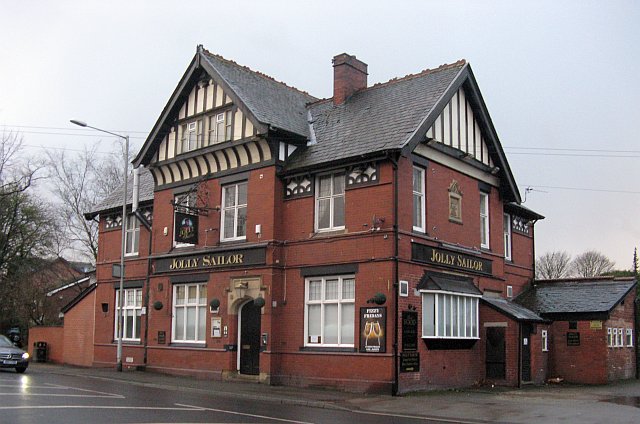
Empty in January 2018.
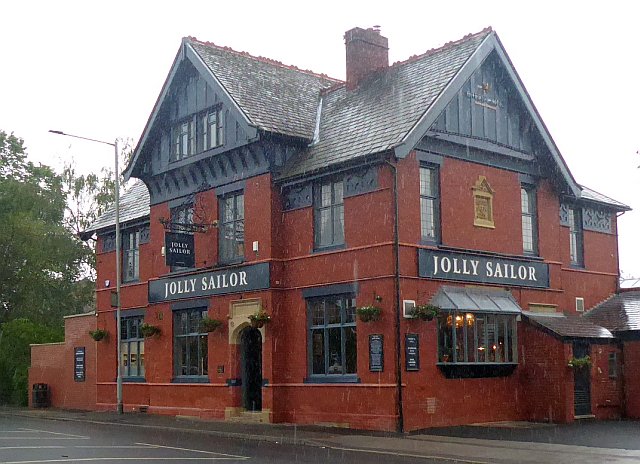
Reopened, June 2019. The brickwork has been washed, restoring the bright appearance as it must have had when built. The new paint scheme for the windows is perhaps not to everyone's taste, but the window frames (but not the 'tudor' gables) have actually been a darker colour before, as the picture from the 1960s shows. The lintels of an original door and window on the near end can be discerned, whilst the kitchen area at the other end has been subtly enlarged. At the rear, a large single-storey 'orangery' offering additional eating area has replaced the 'smoking shelter' built in the 1990s.
Happily, the Jolly Sailor survived the Pandemic and its lockdowns (operating as a take-away for a while) and as I write this in 2o24 it continues to flourish, despite the closure of many other establishments.
[Contents]
Boundary changes in 1901 brought the Charlestown area, formerly part of Bramhall, into the County Borough of Stockport, which in 1974 became, with the addition of the rest of Bramhall along with other nearby parts of Cheshire, the Metropolitan Borough of Stockport.
Charlestown House
Some time before 1861 a large house was built on the other side of Bramhall Lane from the cottages and pub, at the junction with Woodsmoor Lane, in one of the fields previously farmed by James Croft. The occupant in 1861 was Robert Tonge, a Salford-born salesman, aged 33, with his wife Ann Tonge, son Robert Tonge, and a servant. Harriet Wilshaw. Robert (senior) died there in 1872; his widow Ann retained the house until she died in 1876, and the same year the house was sold by auction. Sadly, no picture of the house has come to light, but we can get an idea of what it was like from the auctioneer's description:
A freehold residence known as Charlestown Villa, Bramhall. The inheritance in fee simple of and in that substantial messuage or mansion-house, known as Charleston Villa, in Bramhall, late the residence of Mr. Robert Tonge, deceased, containing dining, drawing and breakfast rooms, closets, domestic offices, good cellars, six bedrooms, dressing-room, bathroom, &c., with good outoffices, vinery, greenhouse, coach house, gardener's cottage, and large well-stocked gardens. The plot contains 4,872 square yards, enclosed within a wall fence, and is subject to the small yearly chief rent of £10. 3s. This very desirable residence is about 600 yards distant from the Davenport station on the railway between Manchester and Whaley Bridge.The resident in 1878 was a cotton spinner, George Edward Pearson with his wife and servants, but by 1881 he had moved on to 'The Poplars' in Stepping Hill. By this time the house was being referred to as Charlestown House; the grounds of the house had been extended to the east into a narrow plot which had in 1841 been rented from the Davenport family by an agricultural labourer, Samuel Hazeldine (age c. 45 - spelled Houden on the Tithe record) and included a small building known as 'Chimney Pot Cottage'. Samuel lived there with his son Charles (9), and in another part of the building lived a cotton weaver William Haynes (c.25) with his wife Sarah and three children, Mary, Jack, and William. Whether this became the gardeners' cottage in the sale advert, or whether it was replaced by the new owner, is obscure.
An 1883 directory brings us to one of the area's more well-known residents, Samuel Kay, whose family were to be the last owners of the house. They moved there from their previous home 'Park House', Turncroft Lane, Stockport. In 1870 Samuel married Sarah Downs, daughter of the late James Downs. They had four children: Florence Sagar Kay (b.1872) Samuel Vernon Kay (b.1875). Gladys Ethel Kay (b.1882), and another who appears to have died in infancy. Florence Sagar Kay later married a merchant, Henry Dixon Mason; in 1911 their home was 'Hazelhurst', Buxton Road, Stockport, and by 1926 at 'Ashford', Bramhall. Their daughter Elydir Florence Dixon Mason (1901-1979) appears again later in our story. Gladys Ethel Kay married Lt.Col. James Charles Herbert Crosland, a Manchester-born engineer, in 1914.
The 1911 census lists the residents of Charlestown House as Samuel Kay, his wife of 40 years Sarah, His 37 year old son Samuel Vernon Kay (who had joined the firm), Daughter Gladys Ethel Kay (29), Cook Annie Dale from Newcastle-on-Tyne and Housemaid Martha Major from Wrenbury, Shropshire. Samuel Vernon Kay had a list for world travel, arising from a world tour with his father when young.
Samuel Kay was, it seems, a more private man than his more flamboyant brother and partner Thomas. He served as a magistrate, but did not seek political office, or engage publicly in cultural activities. In a major philanthropic act, he purchased the land on which was built the Stockport War Memorial Gallery.
In addition to Charlestown House, Samuel bought a country estate in South Wales, Rhydlangoed, now known as Colby Lodge, near the hamlet of Amroth in Pembrokeshire. The house had been built in 1803 for John Colby, a wealthy coal mine owner, incorporating an earlier farmhouse. Samuel, who had enjoyed family holidays in Tenby, bought the estate in 1873, and under his ownership the beautiful gardens which are now owned by the National Trust were developed. On his death the estate passed to his daughter Gladys, who with her husband James Charles Herbert Crosland improved the gardens further. Her niece Elydir Mason inherited the house in 1950. In 2018, you can visit the gardens and even stay in the house.
Samuel Kay died in 1917, leaving - mostly to his family - assents valued at £357,360, equivalent to about £17 million in 2018. The minor bequests in his will are of interest as they five a good idea of the man: £250 to the Heywood Technical School, £100 each to the Pharmaceutical Society Benefit Fund; Stockport Lads' Club; Stockport Infirmary; Stockport Sick Nursing Society. To his book-keeper John William Leather, £100. To his Clerk Mr Leah, £50. £10 each to John Wilkins and George Lewis, if still in his employ. An interesting final bequest was '£5 to each workman, boy and girl, in the employ of the firm'.
Sarah Kay and her son Samuel Vernon Kay lived at Charlestown House until they died, within two days of each other, in January 1926. Both had been ill for some time, and it was thought that the shock of his mother's death led to the son's demise. They shared a funeral.
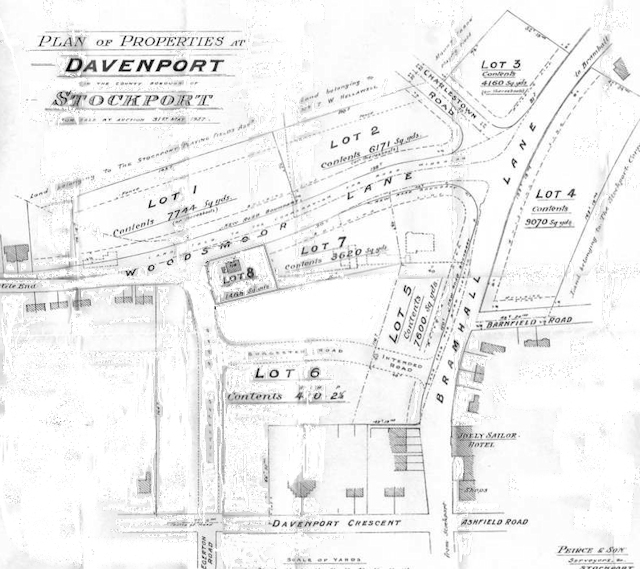
In addition to the house and its gardens, Samuel had also acquired much of the surrounding land, and on 31 May 1927 an auction was held for which the whole estate was divided into eight lots as shown in the (repaired) map. The house, and Moscow Hall farmhouse near the top left of the map, are shown by dotted lines suggesting perhaps that they had already been demolished by the time of the sale, leaving only 'Ivy Cottage' in lot no.8, which still exists in 2018 in extended form. The cottage, 148 Woodsmoor Lane, appears to date from the 1870s, and was owned by Stephen Christy of 'Highfield' at one time. Did he perhaps use it as a Gamekeeper's cottage? A Bramhall directory from the 1870s includes 'Samuel Hall, Head Gamekeeper to Stephen Christy, Esq.' but does not give an address; the cottage does not appear on the c.1872 map, and we have failed to identify Samuel Hall on any census. The sale notice from 1876 mentions a 'gardener's cottage.'
In 1901 and 1911 Ivy Cottage served as the farmhouse of Woodsmoor Lane Farm, the farmer being Alfred Cressy, one of eight children of Robert Cressy, a farmer of Stow Hill, Lincolnshire. The Cressy family developed a business purchasing used grain from brewers and selling it on to farmers as animal feed.
All the land in lots 1 to 7 on the map was sold after the local council has taken some to widen the road, developed for housing. Almost all the houses can be seen to follow a similar design, the style favoured in the 1920s with hipped roofs and bay windows. New roads - Charlestown Road, Woodend Road, and an extension of existing Egerton Road from the Crescent to meet Woodsmoor Lane. The developer of Plot 7 was a Robert Higginbotham, perhaps the man who is recorded at 'Delamere', Frewland Avenue in 1923; he purchased the land from executor George Alfred Downs, uncle of Mrs Kay.
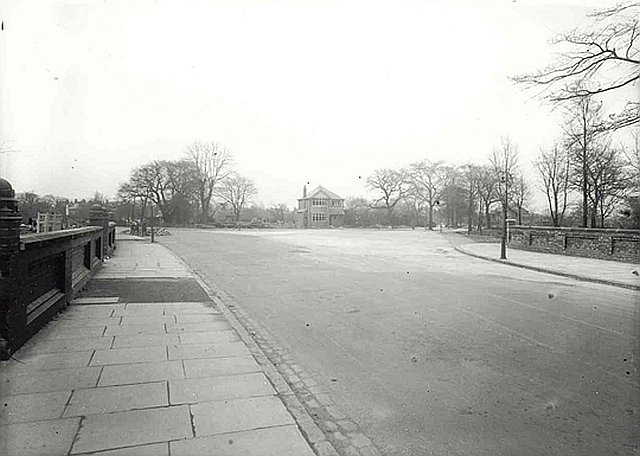
The picture above was taken in 1928 from Bramhall Lane looking towards Stockport, to show the new widened road layout and the standardised garden walls provided; Woodsmoor Lane forks off to the right. Charlestown House has vanished, and the first of new houses is approaching completion, to become no. 331 Bramhall Lane, which stands on the site of Charlestown House.
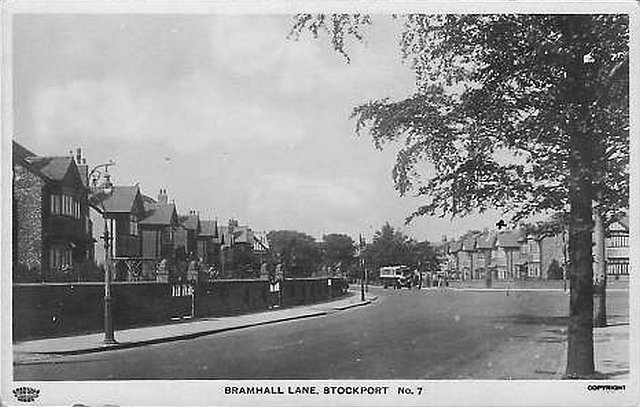
A 'Grenville Series' postcard shows some of the completed houses. In the distance is what we think is one of the Leyland 'Lion' buses bought by Stockport Corporation in 1926, working the Stockport - Woodsmoor service which became route 23. This began operating in 1928 to serve the new houses, terminating at the Woodsmoor Lane junction. For a while in 1931 - 33 buses continued round the corner to Egerton Road before returning to the original terminus. From 1946 it was extended along Woodsmoor Lane to Crossway and back along Moorland Road; some years later it was extended beyond Stockport's boundary to also serve the North Park Road estate across the railway in Bramhall, as still operating as route 372 in 2019.
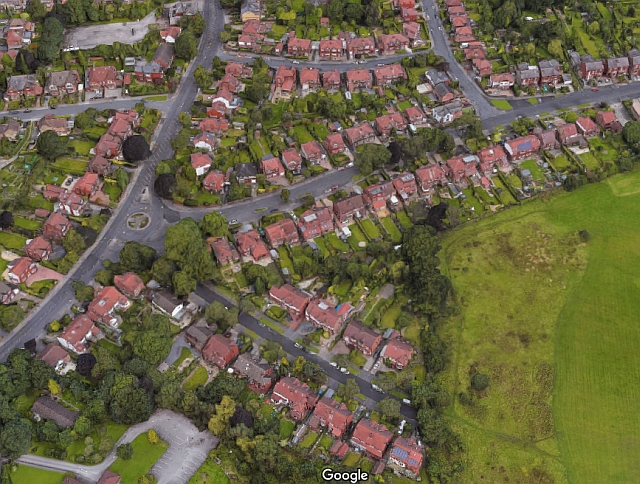
Google's view from 2018 shows very little change to Mr Kay's estate in almost 90 years since the completion of the housing development. The land behind Woodsmoor Lane has has happily been retained as playing fields. There was an intention to continue Charlestown Road across this area, as by 1934 another section of Charlestown Road had been laid out on the other side of the fields, but the link was never made and the two roads had to be suffixed 'East' and 'West.' The same treatment happened to Barnfield Road on the other side of Bramhall Lane - the cul-de-sac Barnfield Road East is a long way by road from Barnfield Road West. [Contents]
The shops
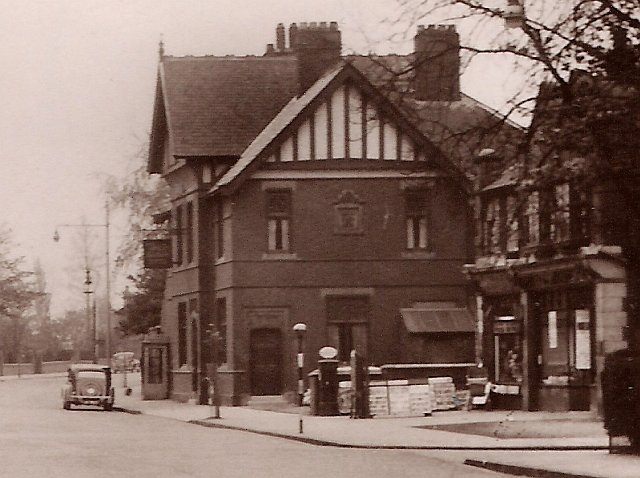
The two shops at 214 and 216 Bramhall Lane, completed early in 1911, are the only buildings (except 'corner shops' on terraces) on Bramhall Lane in Davenport that were actually built for use as shops, rather than being converted from houses. Away from the main shopping area, and adjacent to the Jolly Sailor inn, they served the residents of the many houses which had been built in the area. The picture above, a detail from a late-1930s (?) postcard, is full of interest. The telephone box of the early 'K1' style, and the 'Belisha beacon' which dates the scene to after 1934; 'zebra' stripes, a later addition, are not present. The two shops were not equal in size, with no. 214 being larger even before its later extension.
At No. 214, the 1911 census lists the shopkeeper as Herbert Fielding, a widower born in Droylsden in 1866, helped by his son Ernest and two live-in assistants. The Fieldings were fruiterers who also had a shop at 217 Bramhall Lane in Davenport's main shopping area. It seems that running two shops didn't work out, and they returned to live at 217 where Herbert was still residing in 1939.
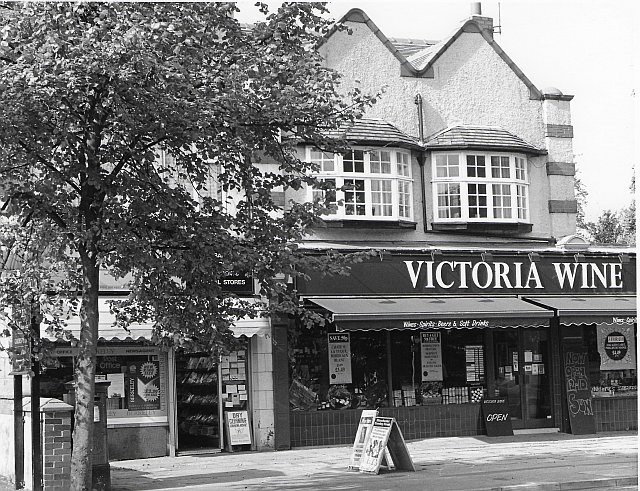
1988 - picture by Philip Bradley.
No. 214 is recorded in 1914 as the business of William Henry Clarke, Ironmonger. By 1924 it had become a branch of Stockport Industrial and Equitable Co-operative Society, who (we believe) built the single-storey extension. The shop later passed to the Augustus Barnett off-licence chain, which went through several take-overs, leading to our shop becoming Victoria Wine, then Threshers before closing at very short notice in 2009 when the parent company collapsed.
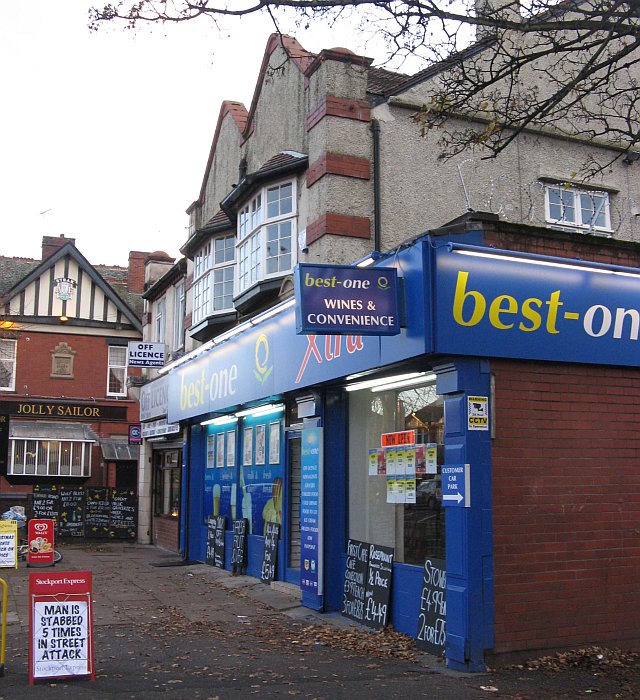
It opened again in 2010 as a 'Best One' franchise convenience store (above) which started well but only lasted until 2012, followed by a long closure before it returned to the Co-operative Group in the form of their funeral service.
The first shopkeeper at the smaller shop, no.216 was Mrs Harriet Burton, who was born far away in Windsor. She appears on the Land Registry record as lessee of the shop from April 1911, and in a 1914 Directory as a confectioner. She did not live above the shop.
Harriet's husband John Burton was born in London in 1852. By 1881 the couple were living in a small cottage in Bond Street, Nelson, Lancashire. He was listed as 'Butler - domestic servant' and she was a dressmaker. They had one daughter, Ada Gertrude, aged 1. Servants would normally live in the home of their employer, but in this case, it would seem likely that he butlered at a large Victorian house just across the road called Spring Cottage, home of worsted manufacturer John Ecroyd and his family. By the next census ten years later, the Burtons had six children, and were living in their grocery shop at 49-51 Burnley Road. By 1901, the family were running a grocery at 1, Woodford Road, Bramhall; perhaps they hoped for a wealthier clientele. They created a small chain of shops in the area each managed by a family member.Unfortunately Harriet died in 1913, and the shop passed to Nathaniel Gould and Company, an expanding group of grocery shops which had been founded in 1848 as a tea merchant in Market Street, Manchester by Derbyshire-born Nathaniel Gould (1824 - 1874), but by this time had been sold to other owners, although trading under the Gould name. The owner was John Harroway, whose life and career is chronicled in our feature about his home, Bamford Grange in Adswood.
By the 1930s No. 216 had become the sub-post-office and newsagent which it remained for many years. The 1939 register lists the residents as Stockport-born Stephen Jackson, born in 1891, son of a grocer, as 'Shopkeeper, newspapers and sub-postmaster' assisted by his wife Alice (née Hackney) and a live-in assistant Margaret Nield, who in 1941 became Margaret Jackson after marrying the other resident, the couple's son Harold Jackson (1912-1994), a motor engineer. Stephen died in 1945.
He was followed as shopkeeper by Sidney Dixon, who lived at 36 Egerton Road and additionally sold groceries. David Alison knew the shop well in the 1950s:
I was a paper-boy in Davenport, for Gibson's newsagents at no. 216, from the age of 11 (would it be allowed nowadays?) to 18, when I went away to college. On Wednesday afternoons my job as a 12-year old was to collect the bundle of copies of Manchester Evening News off the Manchester - Buxton train, which arrived at Davenport around 4.15pm, inevitably steam-hauled hauled by a Fowler 2-6-4T loco. I then had to take the papers to the shopMore recently, the post office trade has been withdrawn, and a licence to sell alcohol gained by later tenants.
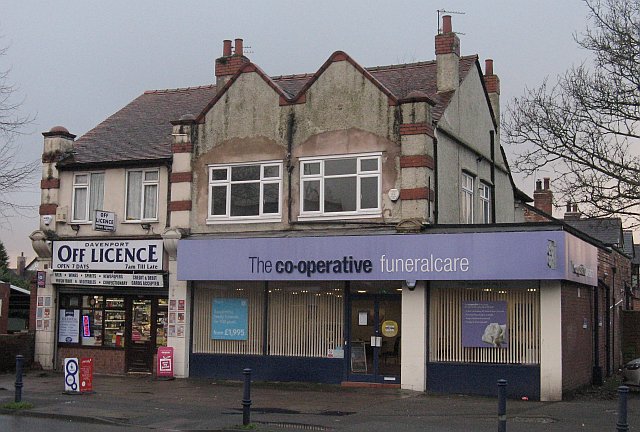
The shops in early 2018, showing the banded brick and render stripes, a feature found on other buildings of the same era such as Stockport Central Library, built in 1915. The original bay windows on the upper floor of 214 were unfortunately been replaced by flat PVC-framed ones c. 2017, with no attempt to tidy up the result. The buildings are within a conservation area; the change was carried out without planning permission, and belatedly came to the attention of Stockport's Conservation Officer, who in January 2019 served the owners (who are not the Co-op) an enforcement order requiring re-instatement of the original window style, which was done, although not an exact replica. The off-licence was re-branded as 'My Shop' soon after this picture was taken. [Contents]
Carlton House School
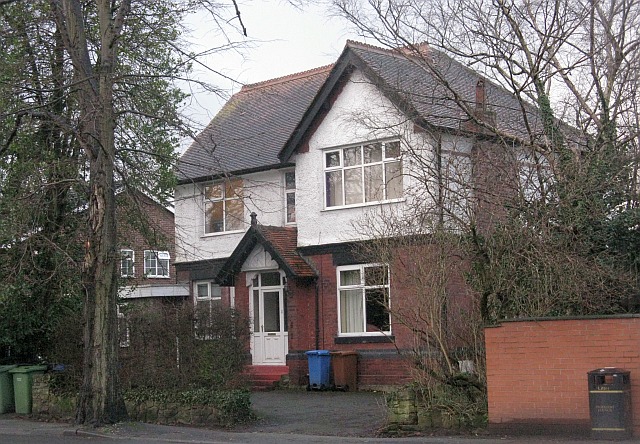
The house at 220 Bramhall Lane, next door to the Jolly Sailor, built on the land purchased in 1883 by James Lamb, has an interesting history. It appears to have been built c. 1906, and from then until 1960 it was operated as a private 'day and boarding School for girls and infants' by a widowed lady, Alice Maria Agnew and her daughters.
(The original 'Carlton House' was an eighteenth-century mansion in London named after early resident Henry Boyle, 1st Baron Carleton, which was the King's 'town house' before Buckingham Palace. The name has been used by establishments of many kinds abound Britain, many of which still dot the map today.)
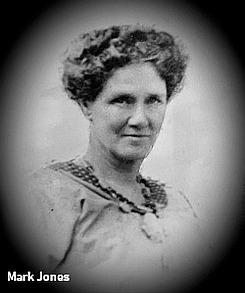 Alice (pictured) was born in Hulme,
Manchester in 1859, one of a large family raised by William
Mitchell, paper hanger and decorator, and his wife
Elizabeth. She married Arthur George Widderburn Agnew of
Welshpool, a watchmaker and jeweller born in Welshpool in
1883. By 1881 they were living and Crewe, but he died in
1884, back in the Manchester area, leaving Alice to make her
own way.
Alice (pictured) was born in Hulme,
Manchester in 1859, one of a large family raised by William
Mitchell, paper hanger and decorator, and his wife
Elizabeth. She married Arthur George Widderburn Agnew of
Welshpool, a watchmaker and jeweller born in Welshpool in
1883. By 1881 they were living and Crewe, but he died in
1884, back in the Manchester area, leaving Alice to make her
own way. She worked as a photographer's assistant for a while before setting up on her own by 1901 as a photographer at 3 Brook Road, Cheadle where her daughter Winifred, who had trained as a teacher, taught private pupils.
By 1911, the census listed Alice Agnew, born in Manchester in 1859, as Matron of the School and her daughter Winifred Rose Agnew, 30, born in Welshpool in 1880, as Head Teacher. Also on hand was her son George H. Agnew, exotically listed as a Canadian fruit farmer, born in Crewe, Cheshire, and daughter Elsie Dorothy Agnew born in Davyhulme, Manchester in 1887. Another daughter, Annie Elinor Agnew, born in Manchester in 1884, was not present in 1911 - she was working as a commercial traveller, and staying in a house in Haslingden, Lancashire on census day. She appears at Carlton House in the 1939 Register.
Madeline Marcellin, age 20, born in France, was resident French teacher in 1911, and there was one boarding pupil, Clarice Broughton, age 10, from London. There were other pupils who attended by day.
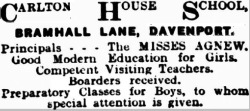 A
newspaper advert from 1924 suggests that boys were admitted,
but this may not have come to pass; certainly by the 1940s
it was for girls only.
A
newspaper advert from 1924 suggests that boys were admitted,
but this may not have come to pass; certainly by the 1940s
it was for girls only.Alice (described as 'incapacitated' in 1939) died in 1950, but the school continued, under the two sisters, until they retired in 1960 to a house in Offerton left to them by a relative.
After the Agnews left, the house became a residence; a 1965 electoral register suggests that the Mead family lived there, with a Mr Dowling as a lodger. In 2021 it retains the name 'Carlton House' on a small plaque by the door. A pair of semi-detached houses, 222 and 224 Bramhall Lane, built in the same period, were demolished in the 1970s and replaced by a modern building comprising four flats.
Some Carlton House memories
The earliest record of a Carlton House pupil we have comes from Mark Jones, who supplied the picture of Alice Agnew shown above. It appears that his grandmother Jessie Moules was an early pupil. Born on the island of Anglesey in 1904 to Robert Moules, a railway labourer born in Birkenhead, and his wife Jane Williams. She died in 1987, and it's not certain whether she was there as a pupil, on some kind of scholarship, or as a domestic servant.
Below are some reminiscences from former pupils in later times.
Bunny Sims writes:
I attended Carlton House from 1944 to 1955 except for one year when my father became seriously ill and could no longer afford the fees of 7 guineas per term; the lunches were 7s 6d per week. I remember Mrs Agnew as always wearing a long black skirt and would always attend the ballet/tap dance lessons which we had.
Along with the usual subjects Miss Winifred Agnew also taught French and after school piano lessons. Miss Dorothy taught elocution and exams were taken at Nield and Hardys in Stockport.
When the Agnews moved to 220 Bramhall Lane they had also rented another house where boarders were cared for by Miss Annie. but When I was there it was only Carlton House, there were no boarders. Miss Annie was in charge of running the household plus cooking lunch time meals.
Miss Annie was a friend of Mrs Reville whose family owned
the Theatre Royal in Stockport. The Agnew sisters retired in 1960 and moved to a house in Offerton, Stockport which had been left to them by a relative. They attended my engagement party and I visited them several times afterwards, once with my son.
Some names I can remember from Carlton House: Susan whose father was a doctor, lived on Bridge Lane; when I went to tea at their house the first time I had dried eggs scrambled. Others were Vivien who lived on Lowfield Road; Rachel and Josie whose grandmother had a cafe on the A6 almost opposite the Brookfield Pub - their father had an ice cream business; and Joy who lived in a bungalow with her parents in Adswood.
After school we would often take the bus to Mersey Square where Bernard the doorman at the Plaza cinema would be waiting for us and take us to the restaurant where my mother worked as a waitress we would have ice cream in silver dishes and then went to watch a film until my mother Phyllis finished work.
The day of Alice's funeral, school was closed. When the Agnew sisters retired in 1960 they moved to a house in Offerton, Stockport which had been left to them by a relative. They attended my engagement party and I visited them several times afterwards, once with my son. The most famous person to attend the school was actress Wendy Hiller, who lived nearby in Bramhall. (See left column).
The Agnews taught me many things with my time with them not only the the "three R's" but much much more. They made such an impression on my life and which I have treasured and still live by today.
Janet Cropper writes:
I was born and brought up in Charlestown Road and was a pupil at Carlton House from 1954 until 1956/7, when the school was still run by the Agnew sisters. They all seemed very old to me (aged 4 in 1954) as they indeed were!
The school at that time had maybe a dozen pupils aged 4 to, I recall, 11 - all girls. Lessons were in small groups: when not being formally taught the pupils were left to their own devices.
Of the two sisters who ran the school in the 1950s, Elsie Dorothy Agnew, known as "Miss Dorothy" died in 1973 aged 85. "Miss Annie", who I recall didn't teach but was in charge of domestic arrangements, died the previous year aged 86. Truly a long-lived family - their brother George returned to Canada and died in British Columbia aged 100.'
[Contents]
Compiled by Charlie Hulme, last update May 2024
Contributions are very welcome: info@davenportstation.org.uk